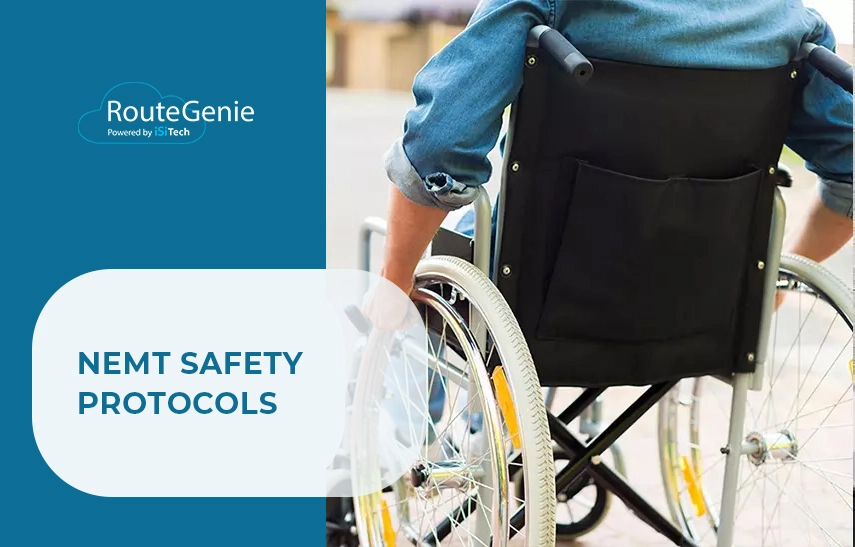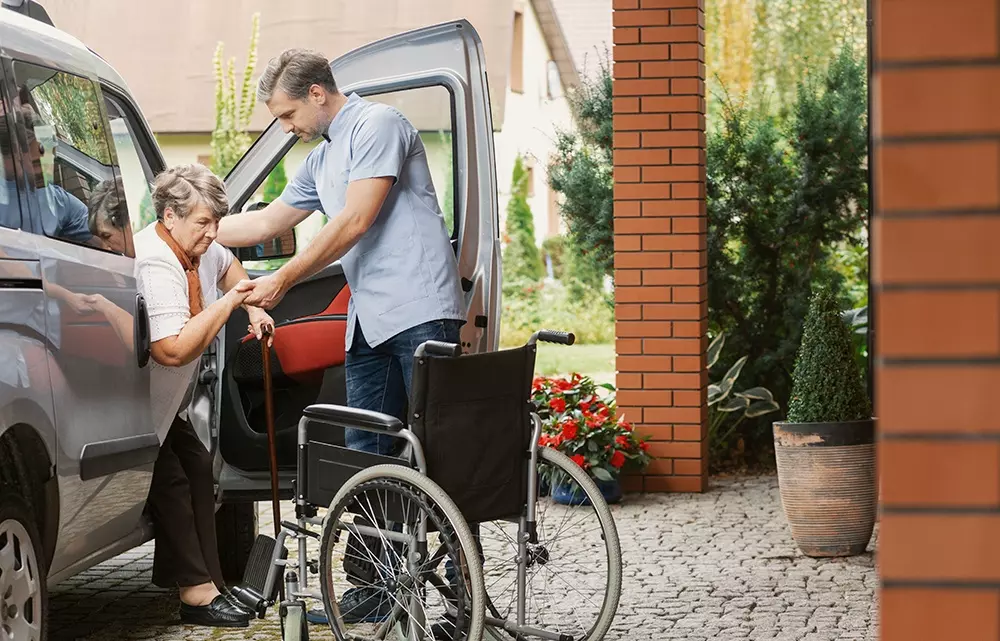NEMT Safety Protocols

Contents:
Patient Loading Safety
When a driver arrives at the patient pick-up point, they usually face one of two scenarios: they have to help the passenger to the vehicle, or the passenger will come out to the vehicle on their own. The driver should know which of these scenarios they’ll have to deal with ahead of time. There are safety protocols in either case, but we’re examining the steps that should be taken when transporting a wheelchair-bound passenger.
Safely Park the Vehicle
When you arrive at the pick-up point, make sure you park in a safe location—avoiding uneven terrain, hills, ditches, and other areas that could pose a problem when parking the vehicle. Make sure there is room to operate the lift and safely secure the vehicle.
Enable the Emergency Brake
It’s always a good idea to put the emergency brake on when parking at the pick-up point. This allows for extra support and assurance that the passenger can be safely transported into the vehicle. Once the brake is engaged, you can safely lower the wheelchair lift.
Help the Passenger Into the Vehicle
When it comes time to load the passenger into the vehicle, the method depends on whether your vehicle has a rear ramp or a side ramp. If the vehicle is side loading, the passenger should be facing away from the vehicle during the loading process. If it’s a rear-loading van, the passenger should be facing towards the vehicle. Once the passenger is on the lift, deploy the brakes on the wheelchair and use the lift safety strap. When the safety strap is engaged, the lift can be safely activated so that the passenger is lifted into the vehicle.
Secure the Passenger Inside the Vehicle
When the passenger is inside the vehicle, go inside the vehicle and secure both the tie-down mechanisms and the straps, double checking that they are both secure and locked. Lastly, ensure the vehicle shoulder strap is placed securely across the passenger. Once everything is secured and double-checked, you’re good to go.
Patient Unloading Safety

When you arrive at the passenger’s appointment, you have to safely unload the passenger from the vehicle. This process is very similar to the loading process, and it’s just as important safety-wise. If you follow these steps, you should have no issue safely unloading a passenger from the NEMT vehicle.
Park the Vehicle in a Safe Location
When you arrive at the appointment, you may be unfamiliar with the area. Luckily, most healthcare facilities offer parking lots to simplify the parking process. If possible, you’ll want to park directly in front of the door, rather than in a spot far from the entrance. Again, avoid any uneven ground and be mindful of which side of the vehicle your passenger exits from, allowing for sufficient room in the area.
Help the Passenger Out of the Vehicle
Once the vehicle is parked, deploy the lift and then head into the vehicle to detach the wheelchair from the interior. Detach the shoulder straps and tie-downs from the wheelchair and assist the passenger onto the lift platform. Ensure that the wheelchair is powered down and the brakes are engaged. Once you’ve verified these safety measures, step outside of the vehicle and use the control to lower the lift. Move the wheelchair to a safe location and make sure the passenger gets into their appointment.
Provide Regular Training for Your Drivers
If you’re a NEMT provider looking for ways to offer the safest experience possible for your passengers, consider offering regular training opportunities for your team. Training can be anything from driver safety and best practice while on the road to passenger care. Whether you offer training once a month or a few times a year, your drivers will benefit from any session that gives them new insights into their job.
Find the Safest Routes for Every Trip
You never know what might happen when you hit the road, so it’s best to have a plan for finding the safest routes. Our non-emergency medical transportation routing software finds the fastest, safest routes for every trip. If you’re ready to upgrade your solution and prioritize safety and efficiency, book a free demo with the RouteGenie team today! Our demos are about 1 hour and are catered to your individual business needs. We can’t wait to hear from you.
About the author

Emmy Kolbe is a copywriter at RouteGenie, where she spends her days writing about non-emergency medical transportation software. She creates content for both emerging and existing transportation companies. She has a bachelor’s degree in journalism and mass communication from St. Bonaventure University.
The author assumes no responsibility or liability for any errors or omissions in the content of this site. The information contained in this site is provided on an "as is" basis with no guarantees of completeness, accuracy, usefulness or timeliness.